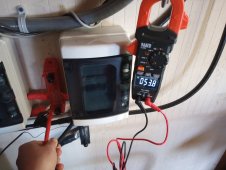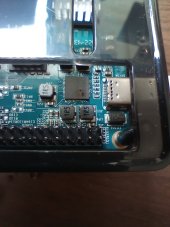I have 2 EG4 6500ex in split phase, and a 6x EG4 Lifepower4 battery bank. And I currently have 3.5kw (400 voc) of solar into PV1 MPPT on my 2p1 inverter. This setup is only supplying AC out to my shed which is powering a small load of about 500W.
I recently received my SA unit and connected the included DC to USB-C cable to my current connected bus bars. It was connected to my 2p1 inverter using the DB9 to RJ45 that came with the inverter and a DB9 to USB adapter from Amazon. It was running just fine for about a week. Before the incident, we had 2 cloudy days, then when we finally had a sunny day, i went to check on the system, and the batteries were showing low SOC, and alarm was blinking on all, and my 2p1 had the solar icon blinking, but not charging. The 2p1 was also showing 60 warning code, which according to the manual is "batteries can't discharge or charge". I restarted all batteries, and both inverters, and the warning went away and solar began to charge.
I decided to check my SA unit to try to see what happened to cause the inverter to go into this state only to find that it was dead. No green light. Checked the DC to USB-C cable, the inline fuse was fine, and I was able to plug my phone into it to get it to charge. The bus bars were supplying 53v at the time. I looked inside the SA unit and found that the chip near the USB-C plug labeled "AXP805" had damage on it.
SA support says that this was most likely caused by a spike in voltage to over 59v and to use an AC power cable instead. This could explain why the batteries were refusing to charge or discharge, perhaps the BMS was protecting them? Does anyone know what could cause a spike in voltage like on the battery connection from the EG4 6500ex inverters?



I recently received my SA unit and connected the included DC to USB-C cable to my current connected bus bars. It was connected to my 2p1 inverter using the DB9 to RJ45 that came with the inverter and a DB9 to USB adapter from Amazon. It was running just fine for about a week. Before the incident, we had 2 cloudy days, then when we finally had a sunny day, i went to check on the system, and the batteries were showing low SOC, and alarm was blinking on all, and my 2p1 had the solar icon blinking, but not charging. The 2p1 was also showing 60 warning code, which according to the manual is "batteries can't discharge or charge". I restarted all batteries, and both inverters, and the warning went away and solar began to charge.
I decided to check my SA unit to try to see what happened to cause the inverter to go into this state only to find that it was dead. No green light. Checked the DC to USB-C cable, the inline fuse was fine, and I was able to plug my phone into it to get it to charge. The bus bars were supplying 53v at the time. I looked inside the SA unit and found that the chip near the USB-C plug labeled "AXP805" had damage on it.
SA support says that this was most likely caused by a spike in voltage to over 59v and to use an AC power cable instead. This could explain why the batteries were refusing to charge or discharge, perhaps the BMS was protecting them? Does anyone know what could cause a spike in voltage like on the battery connection from the EG4 6500ex inverters?





